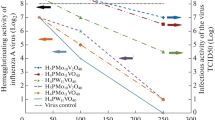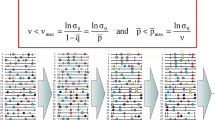Summary
It was found experimentally that 39% of the surviving plaque-forming units are mutants when the total infectivity of the treated sample is decreased by one neperian logarithm through inactivation with hydroxylamine.
Similar content being viewed by others
References
Carp, R., andH. Koprowski: Mutation of type 3 poliovirus with nitrous acid. Virology17, 99–109 (1962).
Cottral, G. E., R. E. Patty, P. Gailiunas, andF. W. Scott: Relationship of foot-and-mouth disease virus plaque size on cell cultures to infectivity for cattle by intramuscular inoculation. Arch. ges. Virusforsch.18, 276–293 (1966).
Dulbecco, R., andM. Vogt: Plaque formation and isolation of pure lines with poliomyelitis. J. exp. Med.99, 167–182 (1954).
Fellowes, O. N.: Hydroxylamine as an inactivating agent for foot-and-mouth disease virus. J. Immunol.96, 772–777 (1966).
Fellowes, O. N.: Application of stresses to foot-and-mouth disease virus. Amer. J. vet. Res.28, 1873–1880 (1967).
Franklin, R. M., andE. Wecker: Inactivation of some animal viruses by hydroxylamine and the structure of ribonucleic acid. Nature (Lond.)184, 343 (1959).
Freese, E., E. B. Freese, andS. Graham: The oxygen dependent reaction of hydroxylamine with nucleotides and DNA. Biochim. biophys. Acta (Amst.)123, 17–25 (1966).
Mundry, K. W., undA. Gierer: Die Erzeugung von Mutationen des Tabak-mosaikvirus durch chemische Behandlung seiner Nukleinsäurein vitro. Z. Vererbungsl.89, 614–630 (1958).
Nottebohm, A., C. A. Gaggero, I. Gomes etR. G. Cunha: Examen antigénique d'un vaccin anti-aphteux inactivé (type “A” Vallée) préparé avec du virus cultivé sur des cellules BHK-21. Bull. Off. int. Epiz.61, (9–10) 919–933 (1964).
Rott, R., undW. Schäfer: Hydroxylamin-Empfindlichkeit des Newcastle Disease Virus (NDV). Z. Naturforsch.17b, 861–862 (1962).
Schäfer, W., undR. Rott: Herstellung von Virusvaccinen mit Hydroxylamin. Z. Hyg. Infekt.-Kr.148, 256–268 (1962).
Schuster, H., undG. Schramm: Bestimmung der biologisch wirksamen Einheit in der RNS des TMV auf chemischem Weg. Z. Naturforsch.13b, 697–704 (1958).
Schuster, H.: The reaction of tobacco mosaic virus ribonucleic acid with hydroxylamine. J. molec. Biol.3, 447–457 (1961).
Schuster, H., andH. G. Wittmann: The inactivating and mutagenic action of hydroxylamine on tobacco mosaic virus ribonucleic acid. Virology19, 421–430 (1963).
Tessman, I.: Mutagenic treatment of double-and single stranded DNA phages T4 and S13 with hydroxylamine. Virology35, 330–333 (1968).
Author information
Authors and Affiliations
Rights and permissions
About this article
Cite this article
Maes, R., Mesquita, J. High mutation rate of foot-and-mouth disease virus treated with hydroxylamine. Archiv f Virusforschung 29, 77–82 (1970). https://doi.org/10.1007/BF01253882
Received:
Issue Date:
DOI: https://doi.org/10.1007/BF01253882




